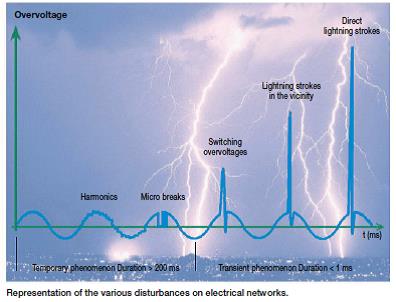Surge protection has increased in profile in recent years however the application of surge protection principles is still a topic shrouded in mystery for many people.

Manufacturers can provide experience through extensive test laboratories capable of recreating the blinding forces of nature. Facilities such as the ABB lighting test laboratory in south west France are capable of generating shock currents of 100kA with a stored energy value of 800kJ, together with impulse voltages up to 200kV. These facilities contribute to the research, design and performance testing of products to suit the most severe applications seen around the world.
Surges, or more correctly transient over-voltages, on the electrical distribution network are a major cause of electronic equipment failure and can result in significant disruption due to production downtime, loss of essential data, as well as direct and indirect damage to equipment.
In Australia we rely on standards to provide guidance and minimum requirements for the application of various protective devices. In the area of surge protection the main Australian standard is AS/NZS 1768, the Lightning Protection Standard. This standard provides guidelines for the protection of people and property from the hazards arising from exposure to lightning. Similar to most standards, AS/NZS 1768 references extensively to the IEC standards as well as some North American UL standards to draw on international experience on dealing with the hazards of lightning. Most international standards have been developed in conjunction with the experience of specialist surge protection manufacturers such as ABB. The result is some comprehensive standards with solutions for overvoltage and lighting protection to take the mystery out of surge protection system design.
Direct lightning strikes are severe and powerful phenomena that can have destructive effects on equipment and installations, however this is not the only type of transient that needs to be considered. If a lightning strike is some distance away from an installation, the massive lightning currents can couple to the electrical network through electromagnetic or capacitive coupling, generating a severe transient impulse on the supply network which can effect equipment. Lower level transients can also appear on the electrical supply network that can cause potential failures to sensitive equipment. These lower level transients are caused by the switching of loads that can create a transient on the network (lighting loads with high inductance, motor starting etc). Research across the world has indicated that as many as 65% of all transients on the network are generated within a building or structure through from load switching and similar network activity.
Various risk assessments have been created over the years to try to analyse the dangers of lightning to a structure. The official assessment linked to the Australian Standard considers a variety of risk factors including:
Structure dimensions
Attributes of the structure
Environment (adjacent structures)
History of lightning in the area
Type of service line
The calculation in AS/NZS 1768 provides a number of risk factors associated with four categories – loss of human life, loss of essential services, loss of cultural heritage and economic loss.
Many users of the standard could make the assessment however it became difficult to interpret the results and decide the best course of action.
To provide a better guidance on the use of surge protection devices (SPD) the recent edition of the AS/NZS 1768 Standard provided a great deal of information on the types of SPD available and the recommended use. This provided an excellent guideline for installers. Part of the information was also included in Appendix F of AS/NZS 3000 as per the table below.
| Categoty | SPD Location | Imax Rating |
| A | Long final sub-circuits and electricity supply outlets | 3-10 kA |
| B | Major sub-mains, short final sub circuits and load centres | 10-40 kA |
| C1 | Service entrance, other than below | 40kA |
| C2 | Service entrance, building fed by long overhead service lines, or is a large industrial or commercial premises | 40-100 kA |
| C3 | Service entrance, building in a high lightning area, or fitted with a Lightning Protection System (Lightning rods) | 100 kA |
In this table the Category identifies various areas in the building including final sub-circuits (Category A);sub-mains, sub-switchboards and load-centres (Category B); and service entrance, main switchboards (Category C – depending upon the supply method and location)
The use of the tables in AS/NZS 3000 and AS/NZS 1768 has allowed much of the mystery of surge protection to be removed. Whilst surge protection is currently not mandatory in Australia according to the wiring rules, it is highly recommended for the protection of sensitive electrical and electronic equipment.

